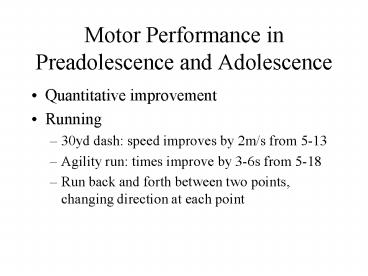Motor Performance in Preadolescence and Adolescence - PowerPoint PPT Presentation
1 / 15
Title:
Motor Performance in Preadolescence and Adolescence
Description:
Girls 14-75ft from 5-15 then slight decrease ... Girls between 14-17 and past menarche. Have adult stature, additional fat weight ... – PowerPoint PPT presentation
Number of Views:96
Avg rating:3.0/5.0
Title: Motor Performance in Preadolescence and Adolescence
1
Motor Performance in Preadolescence and
Adolescence
- Quantitative improvement
- Running
- 30yd dash speed improves by 2m/s from 5-13
- Agility run times improve by 3-6s from 5-18
- Run back and forth between two points, changing
direction at each point
2
Jumping and Throwing
- Jumping
- Horizontal jump increase from 33-50in from 5-9
- 90in at 17
- Girls improved then leveled off around 60in 5-14
- Regressed in mid adolescence
- Vertical jumping 7-17in for boys, 7-12in for
girls from 5-14 - Throwing
- Differences even at early ages
- Boys 24ft to 153ft from 5-17
- Girls 14-75ft from 5-15 then slight decrease
- Boys increase 5.5ft/s per year, girls increase
3.9ft/s
3
Meta-Analysis of Gender Differences
- Pool results of any research studies
- Look at overall differences called effect size
- Running dash, long jump, agility run, sit up
performance, grip strength all followed pattern
of gender differences - Gender differences are most noticeable in
throwing (1.5-3.5 SD) - Fine eye-motor coordination and flexibility favor
girls
4
Factors Influencing Quantitative Performance
- Skills improve but many factors involved
- Developmental pattern, body size, physique, body
composition, strength, and coordination - Girls between 14-17 and past menarche
- Have adult stature, additional fat weight
- Boys increase lean muscle tissue
- Fatness equally detrimental to performance
- Slower, less flexible
- Leisure pursuits genders choose different tasks
- Recently differences are becoming smaller
5
Quantitative vs. Qualitative Assessment
- Can classify children into developmental steps or
measure performance - If planning experiences, qualitative is best to
find appropriate tasks to teach - Quantitative doesnt tell you about skill, just
performance - Once proficient, then quantitative may be more
appropriate
6
Stability in Motor Behavior
- Some educators and coaches want to identify
talent and potential - Look at correlation coefficients
- Relative position among age group
- Generally positive correlations but not high
enough to predict adult performance
7
Skill Refinement
- Children must learn to combine basic skills into
sequences and respond to more dynamic
environments - Cant measure those complex aspects of
performance - Also adapt a movement in changing situations
- Educators can adapt and control situations to
help train these adaptations - Generate multiple levels of difficulty
8
Motor Performance in Adulthood
- Can adolescents continue to improve
- Skills all vary in their requirements
- Skills involving speed decrease
- Skills involving things like accuracy can be
maintained or improved - Sometimes maintain quality of performance, with
less quantity
9
Rate Controllers
- Stereotype that performance goes downhill
- Aging causes loss of bone and muscle mass,
especially when sedentary - CNS is less adaptable
- Reaction time and movement time slow with age
- Found changes minimal in those who stay active
and continue to participate - Nervous system and muscular system are rate
controllers
10
Age at Peak Performance
- A way to examine decline in performance
- Found large variance, dependent on sport
- Peak performances at older ages are continuing to
increase - More acceptable to be an older athlete
11
Performance in Adults
- Quantitative performance in adults
- More masters competitions and senior Olympics
- Decline gradually in middle age
- Big decrease after 75
- Generally, decrease is fairly minimal in active
until after 65 - Qualitative performance in adults
- Few studies look at movement patterns
- Older adults stereotyped as having sedentary
lifestyles
12
Walking
- Gait patterns
- Shorter step length
- Toe out more
- Decreased ankle extension
- Decreased pelvic rotation
- Walk slower
- All due to decreased musculature, flexibility and
former injury - Results same for men and women
13
Running
- Increase stride length to increase walking speed
- Increase stride frequency to increase running
speed - Dont tuck recovery leg as much
- Decreased stride length
- Fewer strides
14
Jumping Throwing
- Jumping
- Decreased knee flexion
- Slower knee extension
- Throwing
- Changes in musculoskeletal system
- Decreased shoulder flexibility
- Decreased fast twitch muscle fibers
- Sometimes movement is changed to adapt to
limitations and no longer optimal or
biomechanically efficient
15
General
- Changes in muscular system that reduce force
production - Decline in posture and balance system
- These are rate controlling factors that cause
older adults to change their movement patterns

